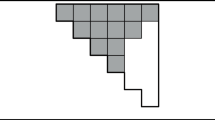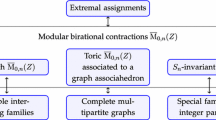Abstract
We establish a combinatorial connection between the real geometry and the K-theory of complex Schubert curves \(S(\lambda _\bullet )\), which are one-dimensional Schubert problems defined with respect to flags osculating the rational normal curve. In Levinson (One-dimensional Schubert problems with respect to osculating flags, 2016, doi:10.4153/CJM-2015-061-1), it was shown that the real geometry of these curves is described by the orbits of a map \(\omega \) on skew tableaux, defined as the commutator of jeu de taquin rectification and promotion. In particular, the real locus of the Schubert curve is naturally a covering space of \({\mathbb {RP}}^1\), with \(\omega \) as the monodromy operator. We provide a fast, local algorithm for computing \(\omega \) without rectifying the skew tableau and show that certain steps in our algorithm are in bijective correspondence with Pechenik and Yong’s genomic tableaux (Pechenik and Yong in Genomic tableaux, 2016. arXiv:1603.08490), which enumerate the K-theoretic Littlewood–Richardson coefficient associated to the Schubert curve. We then give purely combinatorial proofs of several numerical results involving the K-theory and real geometry of \(S(\lambda _\bullet )\).












Similar content being viewed by others
Notes
Note that the definition of corner of \(\lambda /\mu \) depends on the pair of partitions \(\lambda \) and \(\mu \), not just the squares that make up the skew shape. The same square may be both an inner and outer corner; likewise for co-corners.
This phenomenon reflects the fact that both transformations encode the ‘Fundamental Symmetry’ of Young tableau bijections, in the sense of Pak and Vallejo’s work in [13]. Consequently, the composition does not encode this deep symmetry and hence is easier to compute.
We note, however, that \(\omega \) is not a commutator in the sense of group theory, since it involves maps between two different sets. In particular, as computed in Theorem 1.6, \(\omega \) need not be an even permutation.
Our ordering is the reverse of the ordering used in [10].
References
Berenstein, A.D., Kirillov, A.N.: Domino tableaux, Schützenberger involution and action of the symmetric group. Discrete Math. 225(1–3), 5–24 (2000)
Chan, M., López Martın, A., Pflueger, N, Teixidor i Bigas, M.: Genera of Brill-Noether curves and staircase paths in Young tableaux. Preprint, arXiv:1506.00516 (2015)
Eisenbud, D., Harris, J.: Limit linear series: basic theory. Invent. Math. 85(2), 337–371 (1986)
Fulton, W., Tableaux, Y.: London Mathematical Society Student Texts 35. Cambridge University Press, Cambridge (1997)
Gillespie, M.: What do Schubert curves, Young tableaux, and K-theory have in common? (Part I). Math. Gemstones Web, 18 Jan (2016). http://mathematicalgemstones.com
Gross, B., Harris, J.: Real algebraic curves. Ann. Sci. Éc. Norm. Supér. 14(2), 157–182 (1981)
Haiman, M.: Dual equivalence with applications, including a conjecture of Proctor. Discrete Math. 92, 79–113 (1992)
Henriques, A., Kamnitzer, J.: Crystals and coboundary categories. Duke Math. J. 132(2), 191–216 (2006)
Kirillov, A.N., Berenstein, A.D.: Groups generated by involutions, Gelfand-Tsetlin patterns, and combinatorics of Young tableaux. Algebra i Analiz 7(1), 92–152 (1995)
Levinson, J.: One-dimensional Schubert problems with respect to osculating flags. Canadian J. Math. (2016). doi:10.4153/CJM-2015-061-1
Mukhin, E., Tarasov, V., Varchenko, A.: Schubert calculus and representations of the general linear group. J. Am. Math. Soc. 22(4), 909–940 (2009)
Osserman, B.: A limit linear series moduli scheme. Ann. Inst. Fourier 56(4), 1165–1205 (2006)
Pak, I., Vallejo, E.: Reductions of Young Tableau bijections. SIAM J. Discrete Math. 24(1), 113–145 (2010)
Pechenik, O., Yong, A.: Equivariant \(K\)-theory of Grassmannians, Preprint, arXiv:1506.01992 (2015)
Pechenik, O., Yong, A.: Genomic tableaux, Preprint, arXiv:1603.08490 (2016)
Purbhoo, K.: Jeu de taquin and a monodromy problem for Wronskians of polynomials. Adv. Math. 224(3), 827–862 (2010)
Purbhoo, K.: Wronskians, cyclic group actions, and ribbon tableaux. Trans. Am. Math. Soc. 365, 1977–2030 (2013)
Thomas, H., Yong, A.: A jeu de taquin theory for increasing tableaux, with applications to K-theoretic Schubert calculus. Algebra Number Theory 3(2), 121–148 (2009)
Sage: SageMath, the Sage Mathematics Software System (Version 7.3). The Sage Developers (2016). http://www.sagemath.org
Sottile, F.: Frontiers of reality in Schubert calculus. Bull. Am. Math. Soc. 47(1), 31–71 (2010)
Speyer, D.: Schubert problems with respect to osculating flags of stable rational curves. Algebraic Geom. 1, 14–45 (2014)
Stanley, R.: Enumerative Combinatorics, vol. 2. Cambridge University Press, Cambridge (1999)
Acknowledgments
We especially thank Oliver Pechenik for his help with testing our conjectures using Sage [19], and for several helpful discussions about tableau combinatorics. Computations in Sage were very helpful, especially in testing our conjectures and verifying our results throughout this work. We also thank Mark Haiman and David Speyer for their guidance. Finally, we are grateful to Bryan Gillespie, Nic Ford, Gabriel Frieden, Rachel Karpman, Greg Muller and David Speyer for comments on earlier drafts of this paper.
Author information
Authors and Affiliations
Corresponding author
Additional information
The first author was supported by a National Science Foundation GRFP and by the Hertz Foundation. The second author was supported by a Fonds de Recherche du Québec B2 and by National Science Foundation grants DMS-1160720, 1464693 and 1101152.
Rights and permissions
About this article
Cite this article
Gillespie, M.M., Levinson, J. Monodromy and K-theory of Schubert curves via generalized jeu de taquin. J Algebr Comb 45, 191–243 (2017). https://doi.org/10.1007/s10801-016-0705-7
Received:
Accepted:
Published:
Issue Date:
DOI: https://doi.org/10.1007/s10801-016-0705-7




